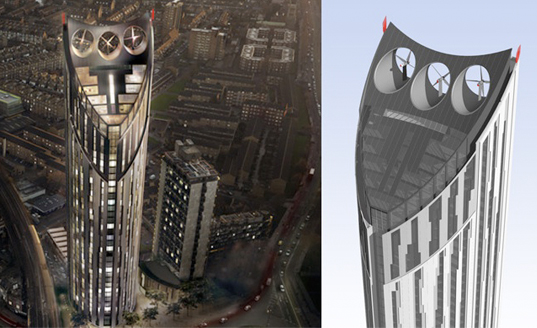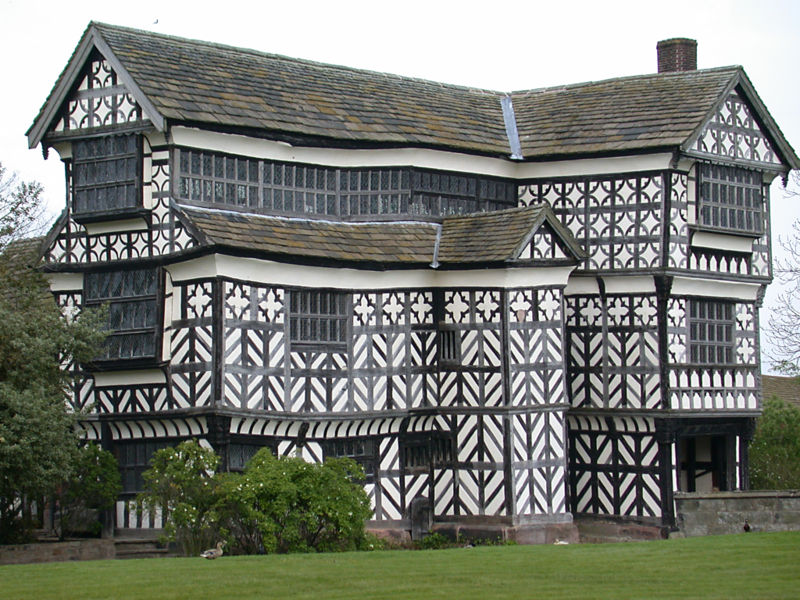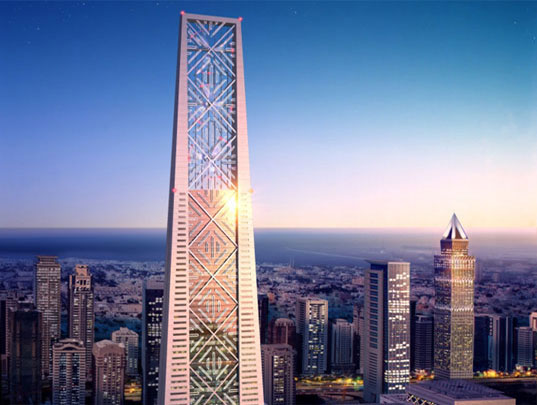珍惜人生,互助互愛
互相提攜勉勵;為我,為你,為我們的子孫後代在海外闖出美好的生活和成功的事業奉獻自己的綿力。
正文
ATCHITECTURAL SUSTAINABILITY
 [Image: The Castle House tower by Hamiltons architects; via Inhabitat].
[Image: The Castle House tower by Hamiltons architects; via Inhabitat].Unlessa "green" building actively remediates its local environment – forinstance, scrubbing toxins from the air or absorbing carbon dioxide –that building is not "good" for the environment. It's simply not as bad as it could have been.
Buildings aren't (yet) like huge Brita filtersthat you can install in a city somewhere and thus deliver pure water,cleaner air, better topsoil, or increased biodiversity to the localpopulation.
I hope buildings will do all of that someday – andsome architects are already proposing such structures – but, for themost part, today's "green" buildings are simply not as bad
Ahigh-rise that off-sets some of its power use through the installationof rooftop wind turbines is great: it looks cool, magazine readers gocrazy for it, and the building's future tenants save loads of money onelectricity bills. But once you factor in these savings, something likethe new Castle House eco-skyscraper still ends up being a net drain on the system.
It's not good for the environment; it's just not as bad as it could have been.
 [Image: The Castle House tower by Hamiltons architects; via Inhabitat].
[Image: The Castle House tower by Hamiltons architects; via Inhabitat].Mylarger point, however, is that you can write about a tower that usesless structural steel, and that tower might be better for theenvironment than, say, a steel-intensive luxury high-rise with threerooftop wind turbines, but your article probably won't get 890 Diggs –and so you write about flashy gizmos with huge downsteam maintenancebills, instead.
To use an inappropriately over-simplified example,imagine two identical 60-story high-rises. The architect of Tower Aconvenes his engineering team one day and they proceed to rearrangesome of the building's internal structural steel; they're thus able tocut out some cantilevers, for instance, and to eliminate excessbuilding material, more generally. This reduces the structure'sembodied construction energy, by which I mean transport costs, steelmanufacture, etc. A few days later, maybe the architect of Tower A evencuts out 10% of the track-lighting, or he makes the office lobbies atiny bit smaller and, thus, easier to climate-control.
The architect of Tower B makes no such changes – but he does add a wind turbine to the roof.
ArchitectA has arguably had a much greater impact on his building'senvironmental bottom line – but we don't hear about Architect A.
Wehear about Architect B, because wind turbines look great, they are easyto explain, and they don't require much journalistic research.
ArchitectB – who has mastered the art of ornamentalizing sustainability – comesoff as a hero; Architect A, despite his accomplishments, is overlooked.
Again, my point is simply that relatively unspectacular designdecisions can be made in the process of constructing a building thatwill help lessen that building's environmental impact – but often thesedecisions aren't flashy. They don't photograph well, and they don'trequire cool new pieces of Digg-friendly technology.
And so your building, however not badit is for the environment, doesn't receive any free publicity on greenbuilding blogs. I'm not pointing fingers, either: this diagnosis is atleast as true for BLDGBLOG.
A relatively lame example here is Tudor residential architecture: as I mentioned back in November, Tudor-style houses are remarkably energy efficient."Wind turbines, solar panels and other hi-tech green devices might getthe media attention," I quote in that earlier post, "but the smartestway to save energy may be to live in a Tudor house and insulate theattic and repair the windows."
 [Image: Little Moreton Hall, "an early model of energy efficiency," according to the Guardian Weekly].
[Image: Little Moreton Hall, "an early model of energy efficiency," according to the Guardian Weekly].In any case, I just think it's worth pointing out that you can compare a new building to the environmental impact of no building at all– in which case you have quite a high bar to clear before your newbuilding is truly "green" – or you can compare that new building to how bad it might otherwise have been.
Ifyou're only doing the latter, then almost literally any minor designdecision – including ornamental wind turbines or a few arbitrary solarpanels – will make that building "green." In the process, "greenbuilding" slowly loses any rigor or integrity it might previously havehad.
Wind turbines, solar panels, rainwater catchment systems, etc.,are totally awesome – I unironically endorse their architectural use –but they don't make a building good for the environment. Or at least they don't yet.
They just make that building less bad for the environment than it would have been without them.
Which is still great – but we shouldn't mistake restraint for generosity.
Inother words, we shouldn't pretend that a steel-intensive high-rise witha few wind turbines on top is somehow good for us; it's just not as bad as it could have been.
Iwould hope that at least long-term readers know that this blog is"pro-sustainability" – I'll even sheepishly point out my own interview with Ed Mazria – but I think it's extremely important to realize that you may be building less bad high-rises, but you are still building high-rises.I remain radically unconvinced that a "green" skyscraper is better thanno skyscraper at all – and yet green skyscraper enthusiasts are outhigh-fiving each other as if their own positive energy is enough tocounteract carbon emissions from the global steel industry.
This is actually one of the reasons why I like Ed Mazria and his Architecture 2030
In a recent press release,Architecture 2030 pointed out that "the CO2 emissions from only onemedium-sized (500 MW) coal-fired power plant" are enough to negate theeffects of planting 300,000 trees in only ten days, among other amazing statistics – including the fact that the entire Architecture 2030 effort,as applied to building renovations, would be negated by the "CO2emissions from just one 750 MW coal-fired power plant each year" fromnow till 2030.
If we want to be "green," Mazria's press releaseimplies, then a far more effective route toward that goal is to changethe coal industry – not to become a luxury high-rise developer inMiami's South Beach (or, worse, in Dubai).
 [Image: The Lighthouse, in Dubai; via Treehugger].
[Image: The Lighthouse, in Dubai; via Treehugger].Being not as bad as you could have been is not a viable future goal for sustainable architecture.
Build something that genuinely improves the environment – build something that has a measurably negativecarbon footprint, for instance, from the manufacture of its steel tothe billing of its electricity – and then I'll be as excited as you areabout how "green" the project really is.
Until then, people whoare only guilty of screwing the environment over partially win hugeaccolades: thank you, we say, for only mugging two people last night – I thought you were going to mug three...
Which is positive reinforcement, sure – but it's not necessarily good for the state of architectural sustainability.
(I apprehensively want to make clear that this post may have been motivated by a post at Inhabitat, but it is in no way meant as an attack on that site; I've linked to, hosted an event with, and even written several posts for Inhabitat.I also want to make clear that I am 100% behind so-called greenbuilding practices; I just don't think a "green" building should bemistaken for an environmental improvement; otherwise it's likemistaking fat-free pound cake for health food: deluded by thepackaging, you eat tons of the stuff and you end up like Dom DeLuise). as they could have been. organization so much.
評論
目前還沒有任何評論
登錄後才可評論.




